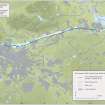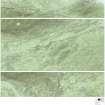Pricing Change
New pricing for orders of material from this site will come into place shortly. Charges for supply of digital images, digitisation on demand, prints and licensing will be altered.
Polmonthill
Temporary Camp (Roman)
Site Name Polmonthill
Classification Temporary Camp (Roman)
Alternative Name(s) Antonine Wall; The Bungalow; Grangemouth Golf Course; Millhall Reservoir
Canmore ID 47871
Site Number NS97NW 11
NGR NS 94710 79042
Datum OSGB36 - NGR
Permalink http://canmore.org.uk/site/47871
- Council Falkirk
- Parish Grangemouth
- Former Region Central
- Former District Falkirk
- Former County Stirlingshire
NS97NW 11 94710 79042
(NS 94710 79042) Roman Camp (R) (site of) (NAT)
OS 6" map (1969).
See also NS97NW 13 and NS97NW 59.
Location formerly entered as NS 947 789.
The possible SE side and rounded SW angle of a temporary camp, shown on 1951 AP's (J K St Joseph 1951), could not be probed by RCAHMS who described it as an indeterminate earthwork with no surface trace.
Later 1964 APs, show what St Joseph described as the remaining NE, SE and SW sides of a small camp c.275ft square; the 1951 ditch apparently being re-interpreted as the NW side (J K St Joseph 1965).
Examination of the available St Joseph APs indicates that the 1951 and 1964 APs do not show parts of a single camp, and that the probable explanation, on available evidence, is that the 1951 ditch is the SE arm of a sizeable camp to which the 1964 ditches form a small annexe approximately of 0.8 hectares. Such an arrangement would be similar in area to the nearby camp and annexe at Little Kerse (NS97NW 12).
RCAHMS 1963, visited 1955.
No surface trace; the area is now part of a golf course and has been turfed and landscaped.
Plotted on 1:2500 maps from APs.
Visited by OS (JRL) 24 February 1981.
Scheduled (with enclosure NS97NW 59) as 'Antonine Wall, The Bungalow, Roman camp 380m W of... the buried remains of a Roman temporary camp, visible as cropmarks, as well as a possible Iron Age enclosure and remains of trenches dug during World War Two. The camp lies wholly within Grangemouth Golf Course and occupies an area of relatively flat ground, with an annexe (NS97NW 59) on the S side of the camp situated on a steep slope. The camp lies around 190m E of Millhall Reservoir (NS97NW 146). Dating to the mid-second century AD, the camp is associated with the construction of the Antonine Wall, situated around 390m to the N. The W side of the camp is entirely visible, measuring 190m in length, and has rounded corners visible at its NW and SW angles. Approxcimately 140m of the S side of the camp is visible and a small rectangular annexe. Around 50m of the N ditch is visible. On the W and S sides of the camp, where the cropmarks are most clearly defined, the ditch is 2.5-3m wide. Immediately to the SW of the camp is a ring-ditch, [which is] interpreted as an Iron-Age enclosure or structure.'
Information from Historic Scotland, scheduling document dated 26 November 2009.
Field Visit (July 1977)
Polmonthill NS 947 790 NS97NW 11
Listed as temporary camp.
RCAHMS 1978, visited July 1977
(St Joseph 1951, 62; RCAHMS 1963, p.449, No. 590; St Joseph 1965, 80)
Publication Account (2008)
A 1:25000 scale map of the Antonine Wall was published by RCAHMS in 2008. The map shows the course of the Antonine Wall on a modern map base, including areas where the Wall is in public ownership or care and can be visited. The data had been collated as part of the project to prepare maps for the World Heritage Site nomination bid.
Publication Account (17 December 2011)
This camp is situated some 400m south of the Antonine Wall between the forts of Inveravon and Mumrills, about 800m west of the former (across the River Avon) and some 3km east of the latter.
It was first recorded through cropmarks by St Joseph in 1945–6, alongside its neighbour Little Kerse, which lies about 300m to the west, separated by the Gilston Burn,now the Millhall Reservoir (St Joseph 1951a: 62). When originally discovered, the site lay in arable fields just to the north of the Falkirk to Linlithgow road, south-west of the farm of Polmonthill, but it now lies in land occupied by the Grangemouth Golf Course.
Additional photographs taken from the air by St Joseph in 1964 led him to state that parts of all four sides had been recorded (St Joseph 1965: 80). However, as the north-east side has not been recorded, but an annexe is known, it is likely that he is referring to the annexe lying on the south-east side of the camp.
The whole of the south-west side has been recorded, together with stretches of the south-east and north-west, suggesting that the camp measured around 220m from north-west to south-east by at least 150m, enclosing a minimum area of some 3.2ha (7.8 acres). There is a possible entrance gap on the south-west side. The annexe measures about 79m from north-west to south-east by 122m transversely, enclosing an additional 0.9ha. As with nearby Little Kerse, the provision of an annexe is unusual, as these have only been recorded at these two camps and at Balmuildy along the Antonine Wall.
R H Jones.


































